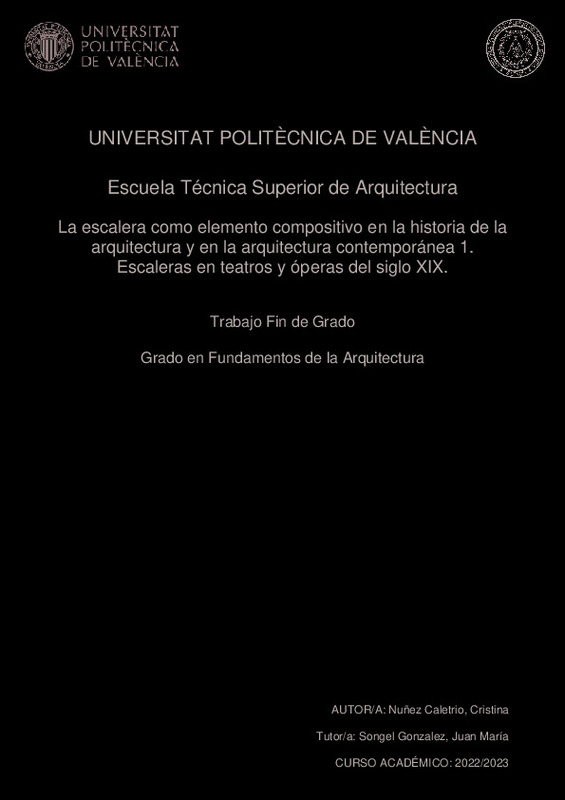JavaScript is disabled for your browser. Some features of this site may not work without it.
Buscar en RiuNet
Listar
Mi cuenta
Estadísticas
Ayuda RiuNet
Admin. UPV
La escalera como elemento compositivo en la historia de la arquitectura y en la arquitectura contemporánea 1. Escaleras en teatros y óperas del siglo XIX.
Mostrar el registro sencillo del ítem
Ficheros en el ítem
| dc.contributor.advisor | Songel Gonzalez, Juan María
|
es_ES |
| dc.contributor.author | Núñez Caletrio, Cristina
|
es_ES |
| dc.date.accessioned | 2023-11-16T09:25:38Z | |
| dc.date.available | 2023-11-16T09:25:38Z | |
| dc.date.created | 2023-09-28 | |
| dc.date.issued | 2023-11-16 | es_ES |
| dc.identifier.uri | http://hdl.handle.net/10251/199865 | |
| dc.description.abstract | [ES] El teatro ha surgido del contacto más estrecho con la religión y sólo más tarde encontró su camino hacia el ámbito del arte puro. De aquí se dice que el único componente esencial del teatro es el público. Por tanto, a la hora de diseñar el edificio del teatro, además de la escenografía, se debe prestar atención en primer lugar a los espectadores, teniendo en cuenta las exigencias que tienen derecho a exigir en materia de comodidad y de seguridad. Esto tiene una conexión directa con los recorridos, tanto de entrada como de salida de personas, trabajadores y asistentes. Los recorridos deben ser claros, para facilitar su comprensión; y eficaces, para garantizar protección. De ahí la relevancia e importancia de las escaleras. Su ubicación, orientación, forma, longitud o geometría, entre otras; ayuda a las personas a una mejor compresión del edificio y por lo tanto, a su mejor recorrido. Por este motivo, el presente trabajo ayuda a desvelar y a poner de manifiesto las diferencias del pensamiento arquitectónico relacionado con el enrutamiento del tráfico y las comunicaciones verticales en importantes edificios públicos tales como óperas y teatros en el siglo XIX. | es_ES |
| dc.description.abstract | [EN] Theatre has emerged from closer contact with religion and only later found its way into the realm of pure art. From this it is said that the only essential component of the theatre is the public. Therefore, when designing the theatre building, in addition to the scenography, attention should first be paid to the spectators, taking into account the demands they are entitled to demand in terms of comfort and safety. This has a direct connection with the routes, both in and out of people, workers and assistants. The routes must be clear, to facilitate their understanding; and effective, to ensure protection. Hence the relevance and importance of the stairs. Its location, orientation, shape, length or geometry, among others; it helps people to better understand the building and therefore, its best route. For this reason, this work helps to reveal and highlight the differences in architectural thought related to traffic routing and vertical communications in important public buildings such as operas and theatres in the 19th century. | es_ES |
| dc.format.extent | 114 | es_ES |
| dc.language | Español | es_ES |
| dc.publisher | Universitat Politècnica de València | es_ES |
| dc.rights | Reserva de todos los derechos | es_ES |
| dc.subject | Escenario | es_ES |
| dc.subject | Escaleras | es_ES |
| dc.subject | Recorrido | es_ES |
| dc.subject | Tramo | es_ES |
| dc.subject | Palco | es_ES |
| dc.subject | Stairs | es_ES |
| dc.subject | Route | es_ES |
| dc.subject | Section | es_ES |
| dc.subject | Box | es_ES |
| dc.subject | Stage | es_ES |
| dc.subject.classification | COMPOSICION ARQUITECTONICA | es_ES |
| dc.subject.other | Grado en Fundamentos de la Arquitectura-Grau en Fonaments de l'Arquitectura | es_ES |
| dc.title | La escalera como elemento compositivo en la historia de la arquitectura y en la arquitectura contemporánea 1. Escaleras en teatros y óperas del siglo XIX. | es_ES |
| dc.title.alternative | The staircase as a compositional element in the history of architecture and in contemporary architecture 1. Stairs in 19th century theaters and operas. | es_ES |
| dc.title.alternative | L'escala com a element compositiu en la història de l'arquitectura i en l'arquitectura contemporània 1. Escales en teatres i òperes del segle XIX. | es_ES |
| dc.type | Proyecto/Trabajo fin de carrera/grado | es_ES |
| dc.rights.accessRights | Abierto | es_ES |
| dc.contributor.affiliation | Universitat Politècnica de València. Departamento de Composición Arquitectónica - Departament de Composició Arquitectònica | es_ES |
| dc.contributor.affiliation | Universitat Politècnica de València. Escuela Técnica Superior de Arquitectura - Escola Tècnica Superior d'Arquitectura | es_ES |
| dc.description.bibliographicCitation | Núñez Caletrio, C. (2023). La escalera como elemento compositivo en la historia de la arquitectura y en la arquitectura contemporánea 1. Escaleras en teatros y óperas del siglo XIX. Universitat Politècnica de València. http://hdl.handle.net/10251/199865 | es_ES |
| dc.description.accrualMethod | TFGM | es_ES |
| dc.relation.pasarela | TFGM\146484 | es_ES |
Este ítem aparece en la(s) siguiente(s) colección(ones)
-
ETSA - Trabajos académicos [4687]
Escuela Técnica Superior de Arquitectura






